Windows 10: The best tips, tricks, and tweaks
Digging deep into Windows 10
Despite still being very much an early preview, Windows 10 is already brimming with dozens of handy tweaks and tricks—and, because the operating is still in preview, a handful of those tricks unlock powerful functionality hidden to everyday users.
Others, though, simply let you mold some of Windows 10’s new features into the shape you see fit. Here are some of the most useful Windows 10 tweaks, tricks, and tips we’ve found. Be warned: Some of these may break as the operating system evolves, though we plan to update this article over time. Got any tricks of your own? Share them in the comments!
Others, though, simply let you mold some of Windows 10’s new features into the shape you see fit. Here are some of the most useful Windows 10 tweaks, tricks, and tips we’ve found. Be warned: Some of these may break as the operating system evolves, though we plan to update this article over time. Got any tricks of your own? Share them in the comments!
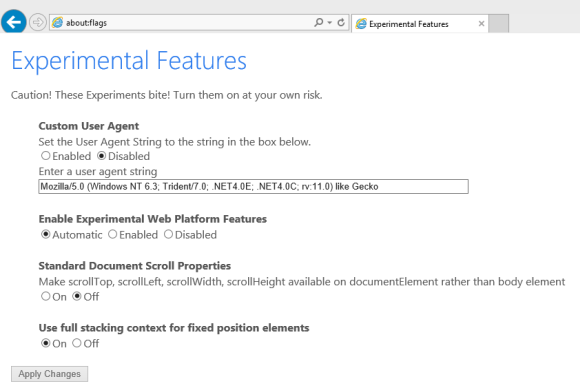
This is(n't quite) Sparta(n)
Let’s start by unlocking one of those powerful new features. Microsoft’s building a lightweight new browser for Windows 10: Project Spartan. And while Spartan isn’t available in the latest Windows 10 builds yet, you can enable its experimental Edge rendering engine in Windows 10’s Internet Explorer 11.
Just open IE11 and type about:flags in the address bar. In the page that appears, simply set “Experimental Web Platform Features” to Enabled, then restart the browser. Setting the “Custom User Agent” string to Enabled as well will trick websites that nerf the old IE engine into using Spartan Edge.
The Edge engine is considerably faster than IE11’s default engine in tests, but be warned: It’s flagged as experimental for a reason.
Just open IE11 and type about:flags in the address bar. In the page that appears, simply set “Experimental Web Platform Features” to Enabled, then restart the browser. Setting the “Custom User Agent” string to Enabled as well will trick websites that nerf the old IE engine into using Spartan Edge.
The Edge engine is considerably faster than IE11’s default engine in tests, but be warned: It’s flagged as experimental for a reason.
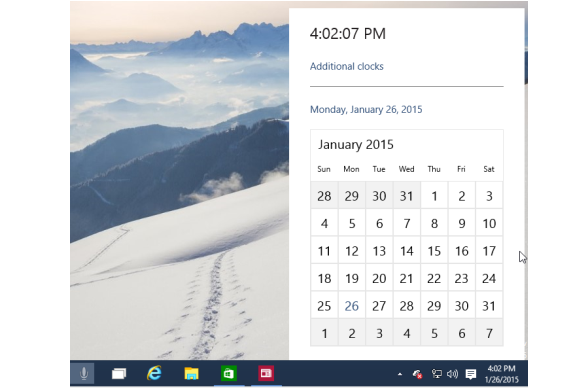
Revamped clock and calendar
While we’re enabling new features, let’s activate Windows 10’s sleek new clock and calendar. Here’s how, as first discovered by Winbeta. It requires a (simple) registry edit, so be sure to make a backup first.
Right-click on the Start button and select Run. In the window that appears, type regedit and then press Enter. Navigate through the file system to HKEY_LOCAL_MACHINE > Software > Microsoft > Windows > CurrentVersion > ImmersiveShell, then right-click in an empty portion of the main windows and select New > DWORD (32-bit) Value. Name it "UseWin32TrayClockExperience" and boom! You’re done. Just open the calendar from the taskbar as normal and bask in the sleek, new look.
Right-click on the Start button and select Run. In the window that appears, type regedit and then press Enter. Navigate through the file system to HKEY_LOCAL_MACHINE > Software > Microsoft > Windows > CurrentVersion > ImmersiveShell, then right-click in an empty portion of the main windows and select New > DWORD (32-bit) Value. Name it "UseWin32TrayClockExperience" and boom! You’re done. Just open the calendar from the taskbar as normal and bask in the sleek, new look.
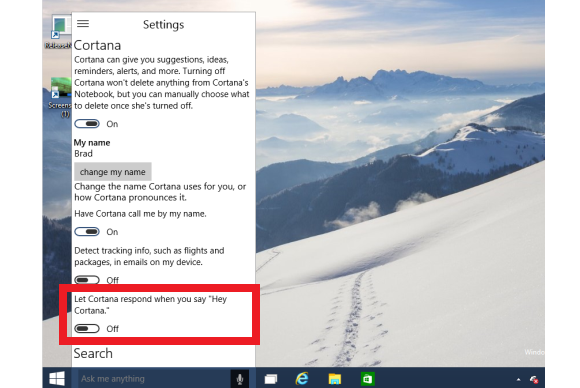
Make Cortana's ears perk up
Cortana’s finally made
the leap to the PC in Windows 10, assuming many of the operating
system’s search functions, even though her first iteration could still use some polish. (That’s what Previews are for!) But by default, she doesn’t listen for your commands.
If you’d like to be able to just bark commands at your PC, open Cortana by clicking the search field in the taskbar and select the three-lined options menu in the upper-left corner. Select Settings for the list, then simply enable the “Let Cortana respond when you say ‘Hey Cortana’” option. You’ll need an active microphone for this to work, of course.
While you’re poking around Cortana’s options, you can dive into the Notebook menu to fine-tune exactly what personal data Microsoft’s digital assistant can access. Remember, however, that like Google Now, Cortana’s effectiveness is directly related to how much she knows about you.
If you’d like to be able to just bark commands at your PC, open Cortana by clicking the search field in the taskbar and select the three-lined options menu in the upper-left corner. Select Settings for the list, then simply enable the “Let Cortana respond when you say ‘Hey Cortana’” option. You’ll need an active microphone for this to work, of course.
While you’re poking around Cortana’s options, you can dive into the Notebook menu to fine-tune exactly what personal data Microsoft’s digital assistant can access. Remember, however, that like Google Now, Cortana’s effectiveness is directly related to how much she knows about you.
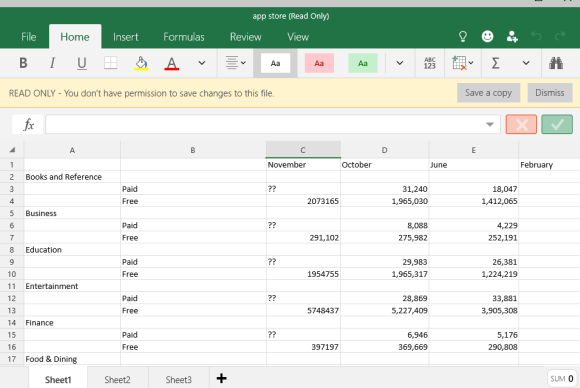
Give touch-friendly Office apps a whirl
First, the good news: Touch-friendly Office apps
are finally nearing completion, in the form of universal apps for
Windows 10 devices of any size and shape. Now, the better news:
Microsoft’s released beta previews of the touch-friendly Word, Excel,
and Powerpoint apps for Windows 10 testers to use at no cost.
You won’t find them in the stable, green-tiled Windows Store, however. You have to venture into the grey-tiled beta Windows Store app to grab the Office previews.
You won’t find them in the stable, green-tiled Windows Store, however. You have to venture into the grey-tiled beta Windows Store app to grab the Office previews.
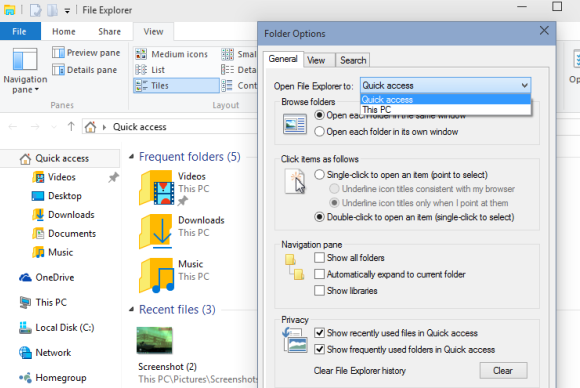
Turn off File Explorer's Quick Access view
When you open File
Explorer in Windows 10, it defaults to a new Quick Access view that
shows your most frequently accessed folders and recently viewed files. I
love it, personally, but if you’d rather File Explorer defaulted to the
“This PC” view found in Windows 8, here’s how.
Open File Explorer, then select View > Options from the Ribbon. A Folder Options window will open. Click the “Open File Explorer” drop-down menu at top, then select the “This PC” option. Click OK and you’re done!
Open File Explorer, then select View > Options from the Ribbon. A Folder Options window will open. Click the “Open File Explorer” drop-down menu at top, then select the “This PC” option. Click OK and you’re done!

Secret, powerful new command line tools
Windows 10 packs a
slew of nifty new command line features, including—hallelujah!—the
ability to copy and paste inside the command prompt with Crtl + C and Crtl + V.
To activate the goodies, open the command prompt. Right-click its title bar, then select Properties. You can find and enable the new features under the Experimental tab.
To activate the goodies, open the command prompt. Right-click its title bar, then select Properties. You can find and enable the new features under the Experimental tab.
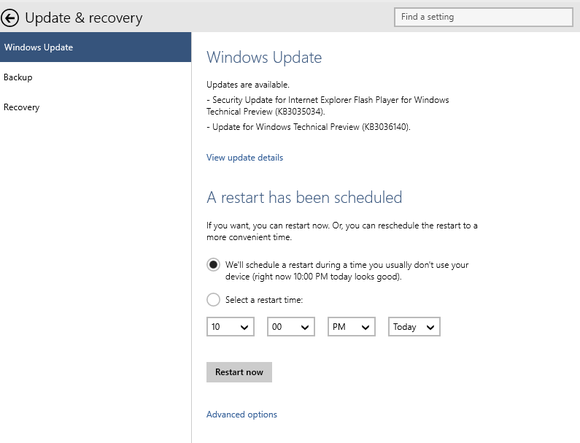
Scheduled your restarts
This is wonderful.
If you’ve got pending updates that require you to reboot your PC,
Windows 10 will allow you to schedule a specific time for it to do so.
Finally!
Open the Settings option in the Start menu, then head to Updates and Recovery > Windows Update. If you have an update pending, you’ll see the screen at left, which lets you schedule your reboot after you select the “Select a restart time” radio button.
Open the Settings option in the Start menu, then head to Updates and Recovery > Windows Update. If you have an update pending, you’ll see the screen at left, which lets you schedule your reboot after you select the “Select a restart time” radio button.

Fresh keyboard shortcuts!
Windows 10 packs a
handful of fresh keyboard shortcuts, all tied to newfound abilities
inside the revamped operating system. There are many more than we can
list here, so head over to PCWorld’s guide to Windows 10’s keyboard shortcuts to learn all about them.

GodMode
The legendary GodMode, a hidden staple for Windows power users, makes its return in Windows 10.
As before, activating it unveils a power user menu that brings together
all of your system’s far-flung settings and configuration options into a
single location. Just create a new folder and rename it to following
GodMode.{ED7BA470-8E54-465E-825C-99712043E01C}
Don’t forget the period after “GodMode”, and you can rename the “GodMode” portion whatever you’d like if you want another name for the folder.
GodMode.{ED7BA470-8E54-465E-825C-99712043E01C}
Don’t forget the period after “GodMode”, and you can rename the “GodMode” portion whatever you’d like if you want another name for the folder.
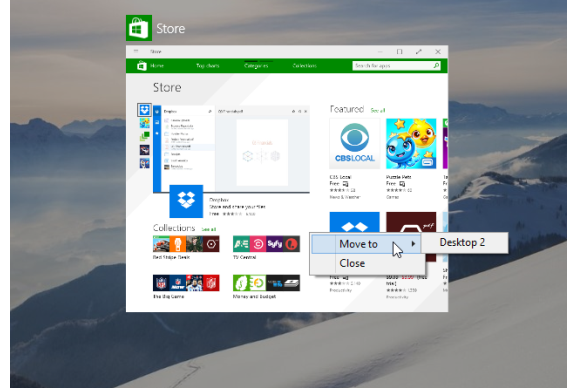
Move open programs between virtual desktops
Virtual desktops let
you segregate your open apps into discrete areas—literally multiple,
virtualized versions of your PC’s desktops. Switching between open
virtual desktops is easy enough using Task View or Windows key + Tab, while Alt + Tab jumps you between open apps across all
desktops. There’s also a way to actually shift an open app from one
virtual desktop to another if you’d like to shuffle things around.
Simply open the virtual desktop housing the open app in question. Click the Task View button in your taskbar—it looks like two papers in front of one another—to bring up an overarching view of your open desktops as well as the open apps inside this virtual desktop. Right-click the program you’d like to move, then select Move to > Desktop [desired virtual desktop number]. Done!
Simply open the virtual desktop housing the open app in question. Click the Task View button in your taskbar—it looks like two papers in front of one another—to bring up an overarching view of your open desktops as well as the open apps inside this virtual desktop. Right-click the program you’d like to move, then select Move to > Desktop [desired virtual desktop number]. Done!
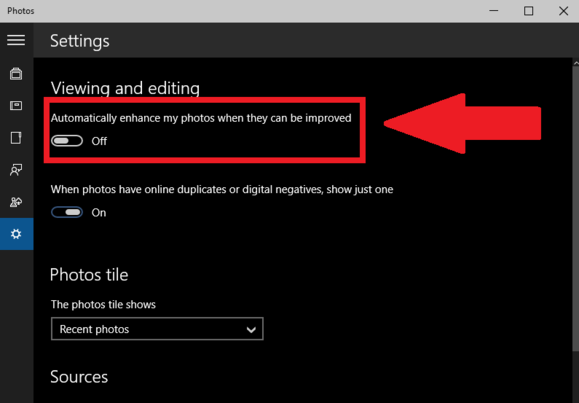
Disable the Photos app's auto-enhance
Windows 10’s Photos
app has been rebuilt as a universal app that scales across device types.
It’s still more than a bit buggy, but one notable feature already
stands out: It will automatically auto-enhance your pictures for clarity
and punch.
If you’d rather Photos left your pictures alone, open the app’s Settings—symbolized by a gear in the left-hand column. Under the Viewing & Editing section, simply disable the “Automatically enhance my photos when they can be improved” option.
If you’d rather Photos left your pictures alone, open the app’s Settings—symbolized by a gear in the left-hand column. Under the Viewing & Editing section, simply disable the “Automatically enhance my photos when they can be improved” option.
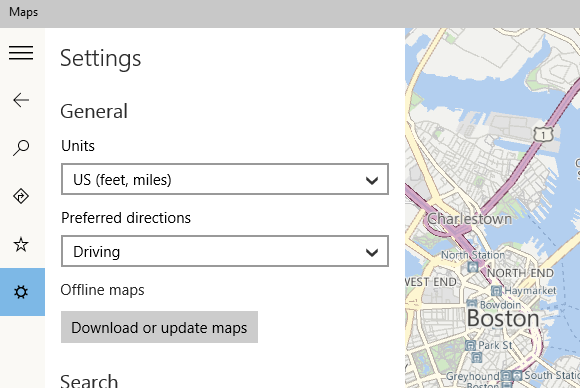
Offline Maps
Speaking of apps, the revamped universal Maps app, like any maps tool worth using (and unlike the Windows 8 Maps app), packs an offline maps feature. Click the Settings (gear) icon in Maps, then select Download or update maps under the “Offline maps” header.
You’ll be bounced to the Settings app, where you’ll be able to select which continent, then country whose offline map you’d like to download. (If you’re downloading a U.S. map, you'll also have to select which state you need.) Helpfully, Windows tells you how large the download will be before you start scraping the maps.
You’ll be bounced to the Settings app, where you’ll be able to select which continent, then country whose offline map you’d like to download. (If you’re downloading a U.S. map, you'll also have to select which state you need.) Helpfully, Windows tells you how large the download will be before you start scraping the maps.
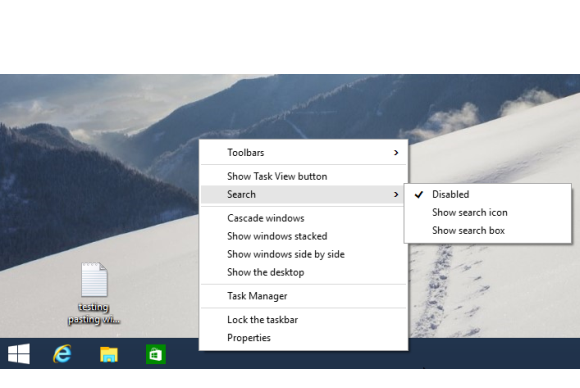
Declutter your taskbar
Two of Windows 10’s standout features
are its Cortana search integration and newly added virtual desktop
support—but they claim a sizeable chunk of your taskbar. If you don’t
care about either (or don’t mind using Windows key + Tab to leap through virtual desktops) you can reclaim that onscreen real estate.
Everything starts by right-clicking an empty section of your taskbar. In the menu that appears, deselecting “Show Task View” eliminates the Task View (virtual desktop) icon, while selecting Search > Disabled removes Cortana’s “Ask me anything” box.
Everything starts by right-clicking an empty section of your taskbar. In the menu that appears, deselecting “Show Task View” eliminates the Task View (virtual desktop) icon, while selecting Search > Disabled removes Cortana’s “Ask me anything” box.
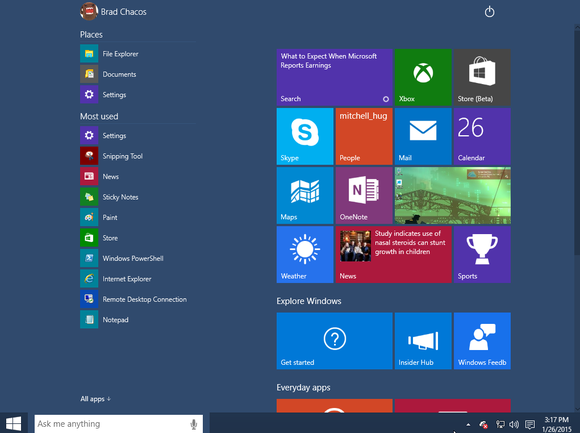
Enable tablet mode
Windows 10’s
Continuum, which dynamically switches from the traditional desktop to a
more Metro-like interface when you’re using a touchscreen, is supposed
to kick into action when you connect or disconnect a keyboard from your
Windows hybrid or tablet. But what if you’re using a standard PC and
just plain love full-screen apps and the Live-Tile-strewn Start screen,
rather than the Start menu?
Easy! Activate tablet mode. Open up Windows 10’s new Action Center—the small icon that looks like a comic-book word bubble in your system tray—and click the Tablet Mode button. It’ll turn blue, the desktop will darken, and Cortana’s desktop box will shrink to an icon to indicate you’ve made the switch. Now bask in the full-screen apps and Start menu, since that's obviously your thing.
Easy! Activate tablet mode. Open up Windows 10’s new Action Center—the small icon that looks like a comic-book word bubble in your system tray—and click the Tablet Mode button. It’ll turn blue, the desktop will darken, and Cortana’s desktop box will shrink to an icon to indicate you’ve made the switch. Now bask in the full-screen apps and Start menu, since that's obviously your thing.
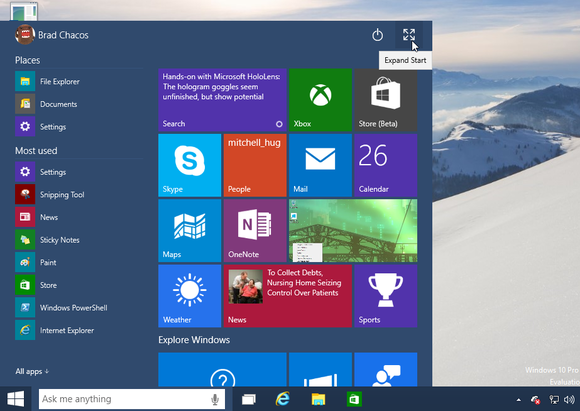
Expand the Start menu to full-screen
If you like the look
of the full-screen Start menu but still rock a mouse and want to stick
to windowed Metro apps, fear not: You can have your cake and eat it too.
Simply open the Start menu, then click the “Expand Start” button in the
upper-right corner to have it mimic the Windows 8 Start screen (and the
picture in the previous slide) every time you click the Start button.
The rest of the desktop continues to behave normally.

Customize your Start menu
Finally, don’t forget
to make the Start menu your own. If you appreciate the blend of the
traditional interface with the Live Tiles, note that you can right-click
on any tile and select Resize to alter the tile’s dimensions—just like on the Windows 8 Start screen.
Alternatively, if you loathe Live Tiles and the Metro interface with the ferocity of a thousand suns, you can also right-click on every one of the defaults in the Start menu and select Uninstall to wipe them from your system. Repopulate them with desktop software of your choosing—you can right-click any app or program and select Pin to Start—and before you know it, it’ll be like the Windows 7 Start menu all over again.
Alternatively, if you loathe Live Tiles and the Metro interface with the ferocity of a thousand suns, you can also right-click on every one of the defaults in the Start menu and select Uninstall to wipe them from your system. Repopulate them with desktop software of your choosing—you can right-click any app or program and select Pin to Start—and before you know it, it’ll be like the Windows 7 Start menu all over again.
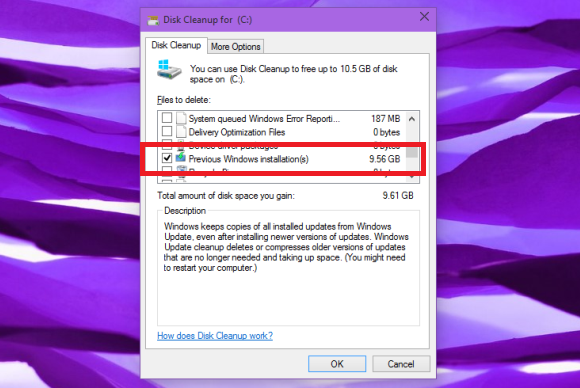
Get rid of the old stuff
When you upgrade to Windows 10 over
an existing Windows 7 or 8 installation, it keeps a copy of your old
operating system around in a folder dubbed Windows.old just case you
need to revert back for any reason. If you know you’re never going back
you can delete that folder to reclaim the lost gigabytes—but it’s not as
simple as right-clicking on it and selecting Delete.
Search for “Free up disk space by deleting unnecessary files”. Click the shortcut, select your primary hard drive (if you have multiple installed), and in the window that appears, click “Clean up system files.” After Windows thinks for a second, check the “Previous Windows installations” box in the list, then click OK and confirm you want to delete the files.
Search for “Free up disk space by deleting unnecessary files”. Click the shortcut, select your primary hard drive (if you have multiple installed), and in the window that appears, click “Clean up system files.” After Windows thinks for a second, check the “Previous Windows installations” box in the list, then click OK and confirm you want to delete the files.
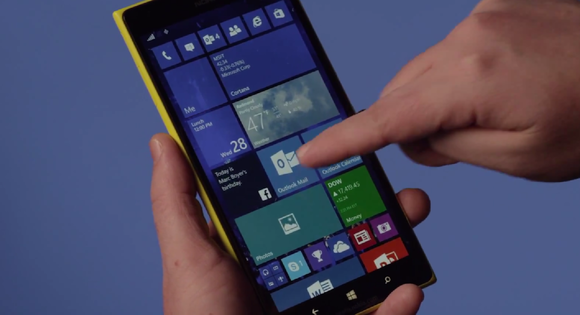
Try Windows 10 for phones!
One of the big draws
of Windows 10 is how it unifies the operating system across device
types. Windows 10 for phones, tablets, and PCs utilize a shared
codebase, universal apps, device synchronization through OneDrive, et cetera. Windows Phones with Windows 10 essentially serve as an extension of your PC.
If you have a Windows Phone, you can try the Windows 10 preview for phones, though be warned: It’s a bit rougher than its PC counterpart. Only a handful of phones can try Windows 10 preview for phones at the moment, although Microsoft is working hard to add more devices to the mix. Our guide on everything you need to know about the Windows 10 preview on phones spells everything out.
If you have a Windows Phone, you can try the Windows 10 preview for phones, though be warned: It’s a bit rougher than its PC counterpart. Only a handful of phones can try Windows 10 preview for phones at the moment, although Microsoft is working hard to add more devices to the mix. Our guide on everything you need to know about the Windows 10 preview on phones spells everything out.
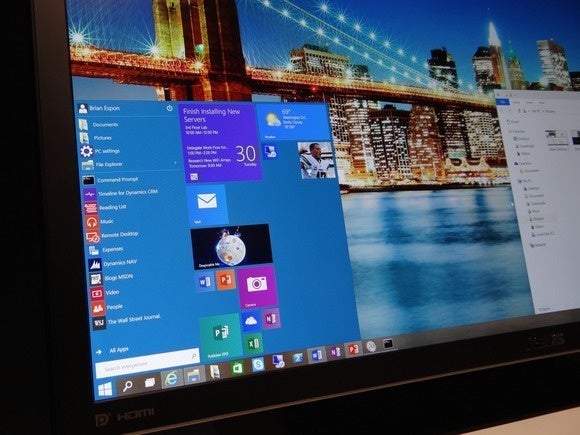
Try it yourself!
Still with me, and wondering how to get in on all this cutting-edge action yourself? Check out PCWorld’s guide on how to install the Windows 10 Preview for all the nitty-gritty information you need to know to start using—or silencing—Cortana today.

Comments
Post a Comment